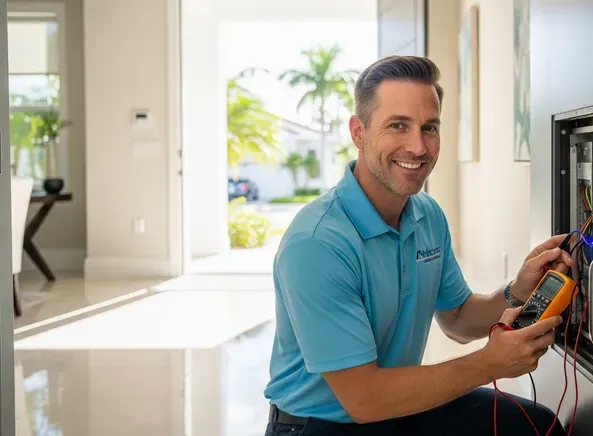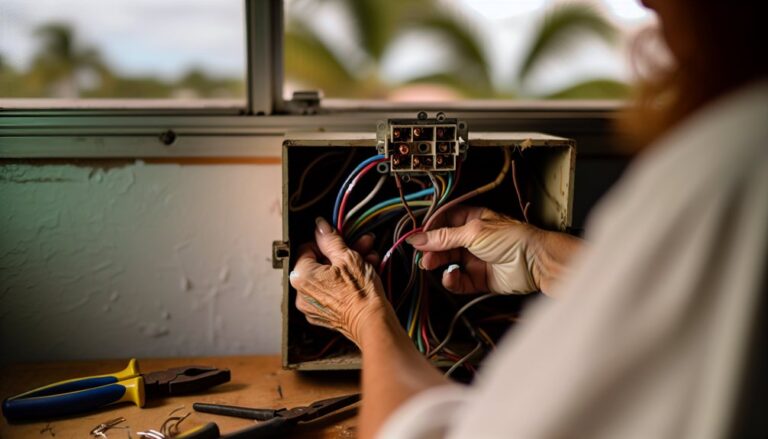Step by Step Electrical Troubleshooting Fort Lauderdale
When troubleshooting electrical issues in Fort Lauderdale, start by ensuring your safety. Wear insulated gloves and goggles, and de-energize the circuit. Identify symptoms like flickering lights or tripped breakers. Check the circuit breaker for wear or signs of tripping and inspect outlets and switches for damage. Use a multimeter for diagnostics. If problems persist, or if you notice burning smells, it’s time to call a professional electrician for safety and proper repairs. More details on the process are available.
Key Takeaways
- Begin by observing symptoms like flickering lights or tripped breakers to identify potential electrical issues in your Fort Lauderdale home.
- Ensure safety by de-energizing the circuit and wearing personal protective equipment (PPE) before troubleshooting any electrical problems.
- Check the circuit breaker for tripping or signs of wear; reset if necessary and monitor for recurring issues.
- Use a multimeter to test outlets and wiring for proper functionality, ensuring all connections are secure and free of damage.
- If problems persist, or if you notice burning smells or scorch marks, call a professional electrician for assistance.

Understanding Common Electrical Issues
When you encounter electrical issues, it’s vital to understand the common problems that can arise in your system. A frequent issue involves faulty connections in common wiring, which can lead to shorts or intermittent power loss.
You should also be aware of overloaded circuits, which often occur when too many devices draw power simultaneously, violating electrical codes designed to prevent such hazards.
Additionally, outdated or damaged wiring can pose serious risks, including fire hazards.
It’s important to regularly inspect your system and make sure all wiring complies with local electrical codes.
Safety Precautions Before Troubleshooting
Before you begin troubleshooting any electrical issue, it’s important to prioritize safety to prevent accidents or injuries. Start by equipping yourself with personal protective equipment (PPE) such as insulated gloves and safety goggles. Always de-energize the circuit before working on it, and use a multimeter to verify that it’s safe. Familiarize yourself with common electrical hazards, including shock and arc flash risks.
Here’s a quick reference table to keep safety in mind:
| Safety Measure | Description | Importance |
|---|---|---|
| Personal Protective Gear | Wear insulated gloves and goggles | Reduces injury risk |
| Circuit De-energization | Turn off power at the breaker panel | Prevents shock |
| Use of Tools | Use insulated tools | Minimizes electrical hazards |
| Work Area Inspection | Check for moisture and obstructions | Promotes safe working conditions |
Identifying the Problem
How can you effectively identify an electrical problem? Start by observing the problem symptoms. Look for signs like flickering lights, tripped breakers, or unusual odors. Each symptom can indicate specific issues.
Next, analyze any issue patterns; for instance, if multiple outlets are affected, it might point to a wiring problem rather than an isolated device failure. Document these symptoms and patterns to help narrow down potential causes.
Always prioritize safety by ensuring the power is off before investigating further. By systematically identifying these symptoms and patterns, you can create a clearer picture, making it easier to tackle the underlying electrical issue efficiently.
Checking the Circuit Breaker
After identifying the problem symptoms, checking the circuit breaker is an essential next step in troubleshooting electrical issues.
You’ll want to inspect various circuit breaker types, including standard, GFCI, and AFCI breakers. First, verify the breaker hasn’t tripped; if it has, reset it and observe if the issue resolves.
For effective circuit breaker maintenance, consider the following:
- Inspect for signs of wear: Look for discoloration, burning, or unusual noises.
- Test regularly: Use a multimeter to verify proper functionality.
- Keep the area clear: Maintain a safe environment around the breaker box to avoid hazards.
Taking these steps helps verify your electrical system remains safe and operational.
Inspecting Outlets and Switches
When troubleshooting electrical issues, you should inspect outlets and switches closely for any signs of malfunction.
Begin by checking different outlet types, such as standard duplex, GFCI, or AFCI outlets, for damage or discoloration. Look for cracks, burn marks, or loose connections, which can indicate underlying problems.
Next, examine switch styles, including toggle, rocker, and dimmer switches. Verify they’re securely mounted and operate smoothly. If a switch feels hot or makes a popping sound, it’s a warning sign.
Always turn off the power at the circuit breaker before conducting any inspections. If you find any irregularities, consider replacing the faulty components or consulting a licensed electrician to verify safety and compliance with local codes.
Testing Light Fixtures
Before testing light fixtures, it’s crucial to guarantee your safety by turning off the power at the circuit breaker.
Once that’s done, you can start checking your fixtures. Consider the following steps:
- Inspect light bulb types to confirm compatibility with the fixture.
- Examine fixture placement to verify it’s not obstructed or damaged.
- Replace any burnt-out bulbs and secure them properly.
After replacing bulbs, restore power and test the fixtures again. If they still don’t work, you may need further investigation.
Always prioritize safety by using appropriate tools and wearing protective gear. Identifying the right light bulb types and confirming proper fixture placement can help you avoid future issues and maintain a well-lit environment.
Utilizing a Multimeter for Diagnosis
To effectively diagnose electrical issues, utilizing a multimeter can greatly streamline the process. Start by selecting the appropriate multimeter settings for your specific needs. For voltage readings, set the multimeter to the AC or DC voltage range depending on your circuit.
| Multimeter Setting | Purpose | Typical Voltage Range |
|---|---|---|
| AC Voltage | Measure alternating current | 0-600V |
| DC Voltage | Measure direct current | 0-50V |
| Resistance | Check continuity | 0-200Ω |
| Diode Testing | Test diodes | – |
| Current (Amps) | Measure current flow | 0-10A |
Always guarantee safety precautions are in place while measuring. Proper use of a multimeter can help identify problems before they escalate.
When to Call a Professional Electrician
Understanding how to use a multimeter can empower you to tackle many electrical issues, but some situations require the expertise of a professional electrician.
Knowing when to consult a professional is essential for your safety and the integrity of your electrical system. Here are some signs of danger that indicate you should call an electrician:
- Frequent circuit breaker trips or blown fuses
- Burning smells or visible scorch marks on outlets
- Flickering lights or inconsistent power supply
If you experience any of these issues, don’t hesitate to seek professional help.
Attempting repairs without proper knowledge can lead to serious hazards, including electrical shocks or fires.
Prioritize safety and guarantee your home’s electrical system is in expert hands when needed.
About Us
We understand that electrical issues can be stressful and overwhelming. That’s why we are here to lend a helping hand and provide you with the best electrical services in town. As a team of experienced electricians, we take pride in our ability to solve any electrical problem with precision and care.
Pages
Follow us
© 2025 By Electrician Fort Lauderdale Today







